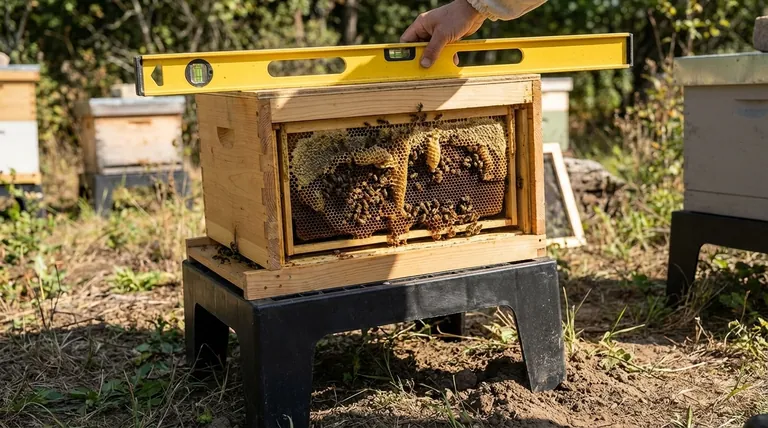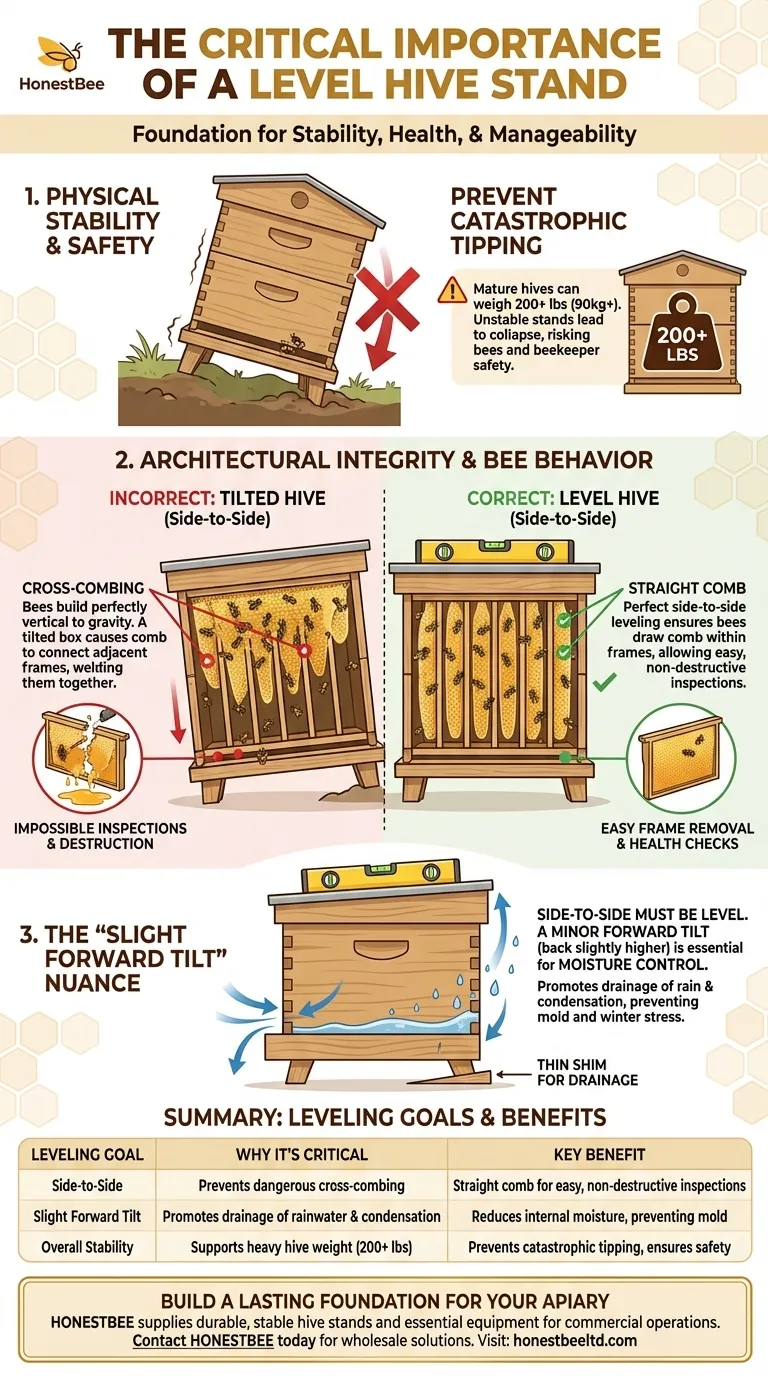Failing to properly level your hive stand creates two distinct and significant problems: one of physical stability for the hive structure, and one of architectural integrity for the bees' comb. Properly leveling your stand is a foundational step that prevents catastrophic failure and ensures the long-term health and manageability of the colony.
An unlevel hive is not just at risk of tipping over. The bees, who build their comb perfectly vertical in response to gravity, will create a structural mess inside a tilted box, making inspections nearly impossible and compromising the colony's work.

The Critical Role of Physical Stability
The most immediate danger of an unlevel hive stand is a complete structural collapse. This poses a risk to the bees, the beekeeper, and anyone nearby.
Preventing Catastrophic Tipping
A mature beehive is deceptively heavy, with a deep hive body full of honey easily exceeding 90 pounds (40kg). A multi-box hive can weigh well over 200 pounds.
If the ground is soft or the stand is not perfectly stable and level, this weight can cause one leg to sink, leading to the entire hive tipping over. This is a catastrophic event that can destroy the colony.
Ensuring a Secure Foundation
A stable, level hive stand provides a secure working environment. During inspections, you will be prying boxes apart and lifting heavy frames. A wobbly or tilted hive makes these tasks more difficult and dangerous.
How Leveling Impacts Bee Behavior and Hive Health
Beyond simple physics, leveling the hive correctly is crucial for working with the bees' natural instincts, not against them. Bees are master engineers who rely on gravity for their construction projects.
The Foundation of Straight Comb
Bees use gravity as their vertical reference, building honeycomb straight down with remarkable precision. In a hive that is level from side-to-side, this means they build their comb perfectly within the confines of each hanging frame.
The Problem of Cross-Combing
If a hive is tilted to one side, the bees will still build their comb straight down. However, this comb will now be at an angle relative to the frames.
This often leads to cross-combing, where the bees build comb that attaches to two adjacent frames. This welds the frames together, making it impossible to remove one without tearing the comb, destroying brood, and spilling honey.
Complications for Hive Inspections
The primary goal of cross-combing is to make routine inspections a destructive and frustrating process. A beekeeper cannot assess colony health, check for pests, or manage space if the frames are stuck together.
Understanding the Trade-offs: The "Slight Forward Tilt"
While side-to-side leveling is non-negotiable, many experienced beekeepers intentionally introduce a very slight front-to-back tilt. This is a calculated decision to solve a different problem: moisture.
Side-to-Side Leveling is Absolute
To prevent cross-combing, your hive must be perfectly level across its width (from one side to the other). Place your level on top of the uppermost hive body, running parallel to the front entrance, and ensure the bubble is dead center.
The Benefit of a Minor Forward Tilt
By making the hive slightly lower in the front than in the back, you create a gentle slope. This encourages any rainwater that blows into the entrance or condensation that forms inside to drain out the front of the hive.
This simple adjustment is a powerful tool for preventing moisture buildup, which can lead to mold and stress on the colony during winter.
How to Achieve the Correct Tilt
After you have leveled the hive side-to-side, turn your level so it runs from the back to the front. You only need a very small tilt—just enough for the bubble to be slightly off-center toward the high (back) side. A shim as thin as a quarter or a small washer under the two back feet of the stand is often sufficient.
Making the Right Choice for Your Goal
Setting up your hive stand is your first opportunity to establish a stable, healthy, and manageable environment for your bees.
- If your primary focus is colony health and ease of inspection: Prioritize getting the hive perfectly level from side-to-side to ensure the bees draw straight comb within the frames.
- If your primary focus is protecting the hive from the elements: After leveling side-to-side, introduce a slight forward tilt to promote drainage and keep the interior dry.
- If your primary focus is long-term stability: Place your stand on a firm, prepared foundation like concrete blocks or pavers to prevent it from sinking into the ground over time.
A few minutes with a level before you place your bees is one of the most effective investments you can make for a successful beekeeping season.
Summary Table:
| Leveling Goal | Why It's Critical | Key Benefit |
|---|---|---|
| Side-to-Side | Prevents dangerous cross-combing by bees | Straight comb for easy, non-destructive inspections |
| Slight Forward Tilt | Promotes drainage of rainwater and condensation | Reduces internal moisture, preventing mold and winter stress |
| Overall Stability | Supports heavy hive weight (200+ lbs) on a firm foundation | Prevents catastrophic tipping and provides a safe working environment |
Ensure your apiary's foundation is built to last. HONESTBEE supplies durable, stable hive stands and essential beekeeping equipment to commercial apiaries and distributors. Our wholesale-focused operations provide the reliable supplies you need to maintain healthy, manageable colonies. Contact HONESTBEE today for your commercial beekeeping equipment needs.
Visual Guide

Related Products
- Plastic Bee Hive Stand for Beekeeping
- Metal Bee Hive Stand Bee Box Stand for Beekeeping
- HONESTBEE Classic Pry Bar Hive Tool with High Visibility Finish for Beekeeping
- Professional Drop-Style Hive Handles for Beekeeping
- Yellow Plastic Bucket Pail Perch for Beekeeping
People Also Ask
- Why is elevating the hive important? A Simple Step for a Healthier, More Productive Colony
- How does the longevity of plastic bee hives compare to wooden hives? Discover the Durable Choice
- How do plastic bee hives compare to wooden hives in handling? Reduce Strain & Boost Efficiency
- How do bees regulate the temperature of their hive during the summer? Discover Their Natural Cooling System
- How do bees regulate ventilation and temperature in the hive? Master Hive Climate Control



















